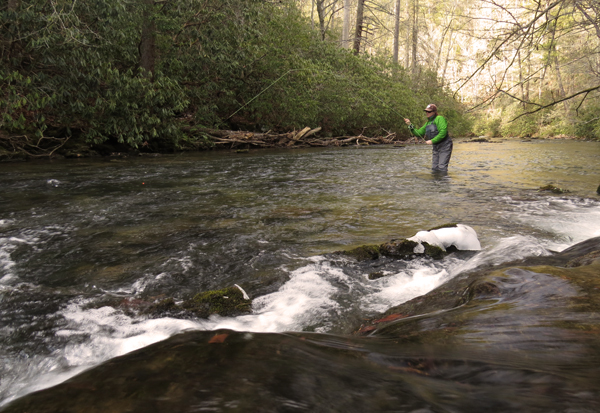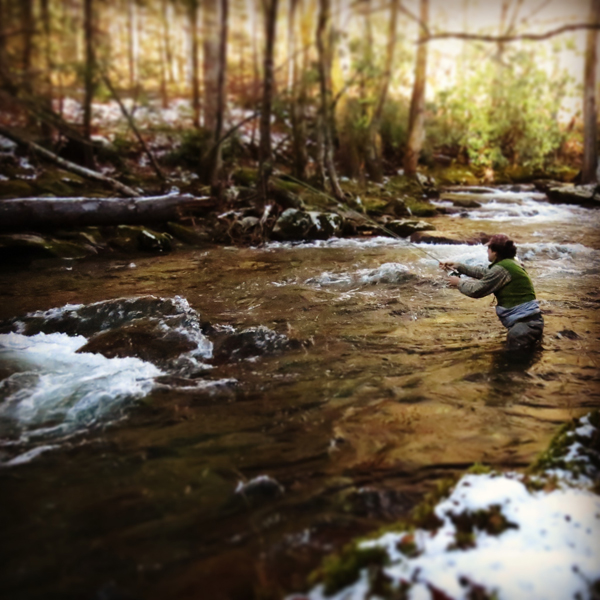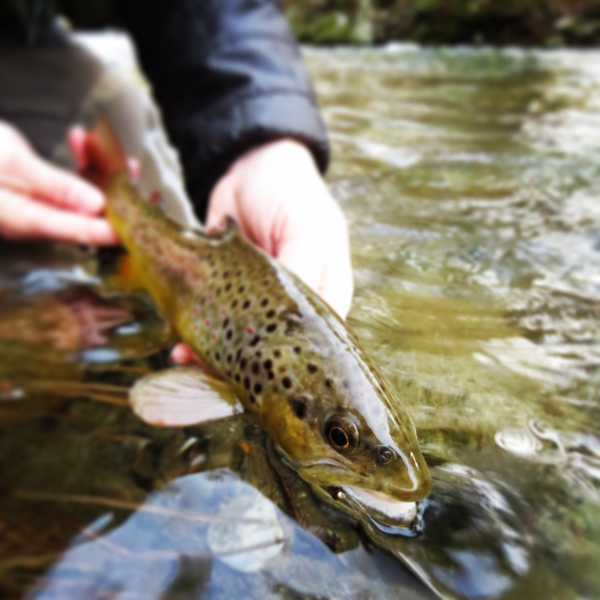Fly fishing with nymphs has always been a little bit of a mystery for anglers. You cast a fly you can’t see to a fish you can’t see, so it’s completely understandable when the concepts are hard to master. The most basic element to success when fishing with nymphs is finding the appropriate depth. There is usually an optimal depth for success but most anglers find themselves fishing one of two depths – too shallow or too deep.
We have a pretty standard approach to nymphing when guiding. We have a consistent starting point followed by adjustments until we hit upon a pattern. When guiding in the Smokies we almost always rig a nymph between 24″ – 30″ underneath a strike indicator. We prefer to fish two nymphs, but don’t feel like that’s a necessity. The nymph should be weighted, but we prefer to forego a super heavy fly at the start.
Work shallow waters first
While many anglers are attracted to big pools and deep plunges, we start by working pockets and runs of water that are in the range of 2′ – 3′ deep. This is a great place to start. Even if the fish are glued to the bottom, your flies will be in their strike zone. If fish are taking your nymph in this type of spot, you’re off to a great start and experimenting is much easier. If you fish a string of spots like this without any positive reaction from fish it’s time to try something new.
Gradually go deeper
The next step is to focus on deeper water and set your strike indicator another 12 – 24″ deeper depending on just how deep the water is. It’s also important to focus on spots with relatively slow current. This doesn’t necessarily mean fishing the deep center of a large pool. It’s better to find deeper pockets of slow water bounded by swift water. Lethargic fish will take up residence in this type of water in the Smokies. An added benefit of fishing a pocket is that your fly should be very close to a fish. This is so important when fish are not actively feeding. A sluggish trout is far more likely to eat your nymph if it’s very close, but may not even notice if it’s more than two feet away.
Use split shot
You may have cracked the code at this point, or you may still be searching for your first strike. The next step is to use a piece of split shot. This will not only get your fly deeper but it will get it there quicker. We rarely use shots that are very big. A shot in the #4 or #6 is usually about right. This is where things start to get a little fuzzy and there’s rarely a precise “correct depth”. Be open to changing depth of your flies with the depth of each spot you fish. You’ll want to occasionally tick bottom, but your fly shouldn’t get hung up very often.
Never Assume You Snagged Bottom
Most anglers are surprised how their nymph can be right on the bottom but not get snagged. As guides we see far too many strikes by trout that anglers assumed were snags. Your flies are small and the rocks in the stream are very smooth so hooking bottom should be somewhat uncommon. Most outright snags come from your hook catching on wood, not hanging on the stream bottom. This is where having too much weight becomes a liability. If you constantly hang up on bottom, it’s because your rig is too heavy. Setting the hook on non-strikes frequently tends to make you a bit less responsive over time and miss the quick strike of a trout when it does happen.
Distinct pauses in the drift of your strike indicator should be fish. It’s common to hear guides say “Hook sets are free, so don’t be chincey with them!” and it’s so true. Most anglers are surprised how often what they thought was bottom is really a fish. Winter strikes are often more discreet than later in spring and summer when fish are more active and take a fly with more gusto. Set the hook on anything suspicious and you’ll likely be surprised how often it really was a fish!
Just Have Fun
Sometimes you’ll hit a particularly slow day of fishing and find nothing you do entices a strike. On those days I’ll sometimes get rid of the nymphs all together and just enjoy casting a dry fly. If you’re not going to catch them, you might as well not catch them on a dry fly! What’s more, I’m still surprised how often a trout will rise to a dry fly when all my best efforts with a nymph went unnoticed. Just make sure you find a way to keep it fun whether the fishing is fast and furious or super slow.


